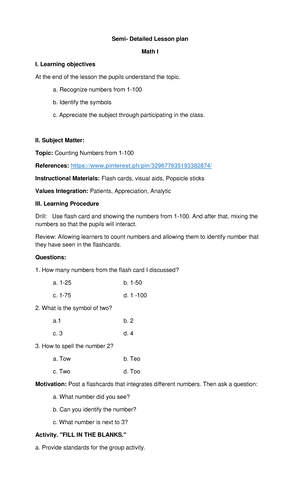- Information
- AI Chat
Was this document helpful?
Volcanic Eruption - SCIENCE 9
Course: BS Secondary Education (DRRR 01)
999+ Documents
Students shared 3575 documents in this course
University: Cotabato State University
Was this document helpful?

Republic of the Philippines
COLEGIO SAN JOSE DE ALAMINOS, INC.
COLLEGE DEPARTMENT
COLLEGE OF ARTS AND SCIENCES
Alaminos City, Pangasinan, Philippines
A.Y. 2022-2023
Detailed Lesson Plan
In Grade 9 Science
Time Frame: 60 minutes
I. Objectives
At the end of the lesson, the students should be able to:
1. Explain what happens when different volcano types erupt and enumerate the
factors that trigger volcanic eruption.
2. Demonstrate measures to undertake before, during, and after volcanic
eruption.
II. Content Standard
The learners demonstrate understanding of the factors that affect climate, and the
effects of changing climate and how to adapt accordingly.
III. Performance Standard
The learners should be able to participate in activities that reduce risks and lessen
effects of climate change.
IV. Learning Competencies
1. Explain what happens when different volcano types erupt and enumerate the
factors that trigger volcanic eruption. (S9ES-IIIb-28)
2. Demonstrate measures to undertake before, during, and after volcanic
eruption. (S9ES-IIIb-28)
V. Subject Matter
Topic: “Volcanic Eruption”
References: Grade 9 Science Links Textbook page 212-219 and, "Volcanic
Eruptions", USGS, https://www.usgs.gov/natural-hazards/volcano-
hazards/volcanic-eruptions
Materials: Power Point Presentation, Infinity Cubes, Construction Paper, Activity
sheets, Handouts, Recitation Pass, TV, USB, Coke and Mentos, Boards and Chalk.
VI. Procedures
Teacher’s Activity Student’s Activity
A. Preliminary Activities
1. Prayer
Good morning, Class! Peace and all Good!
Everybody stands up! Prayer leader please.
2. Checking of Attendance
Okay class, before take your seats, kindly
pick up those pieces of trash and arrange
your chair properly.
Also, kindly remove those unnecessary
Good morning, Sir, Peace and all Good.
Classmates, are you ready to pray?
(In the name of the Father……)
(Students will prepare their seats and surrounding for a







